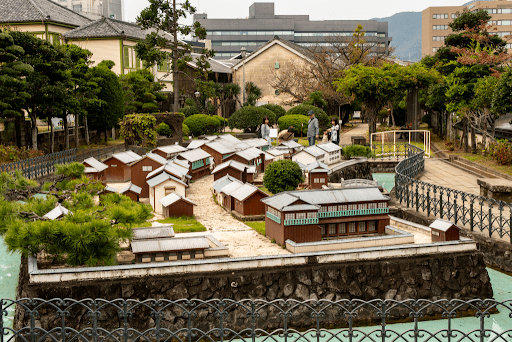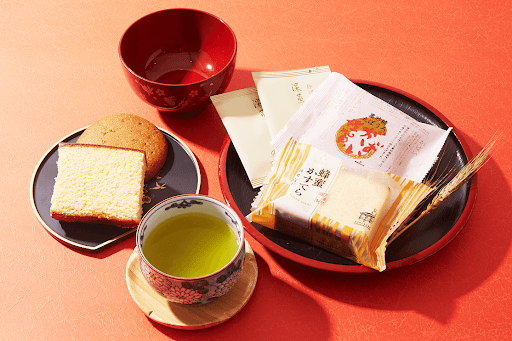cake, castella, sugar
The Best Castella Cake Masters from Osaka: Sanseisha
Christian Closs
Posted on May 10, 2022
Share:

Sponge cake isn’t a common traditional Japanese snack, but Japan’s history of castella cake is centuries long. One of Japan’s first ‘Western-style confectioneries’, the fluffy cake is now more popular in Japan than in its origin country of Portugal and influenced other Japanese sweets.
Where did castella cake come from?
For many foreign things introduced to Japan, the southern Japanese island of Kyushu was the first point of contact, and sugar is no different. When Portuguese missionaries arrived in 1543, many of their gifts had never been seen before, and European-style confectionery was one of them.
Rich confectionery made with eggs, flour, and refined sugar completely differed from lightly flavored Japanese sweets made with plant-derived sweeteners. As a result, it quickly led to an emerging appetite for more. Until this trade began, sugar was primarily for medicinal uses due to its cost. New trade routes made it more accessible, and a dessert culture emerged.
How long did trade with the Portuguese last?
The shogunate, over time, brought an end to the Portuguese missionary efforts. Consequently, Japan closed its doors to foreign visitors in 1641, marking a shift in its approach to external influences. Despite this closure, trade persisted with the Dutch through a specially constructed artificial island.
This unique arrangement ensured a continuous flow of commodities, particularly sugar and butter. The controlled engagement with the Dutch allowed Japan to maintain a level of external interaction while still exercising significant control over its borders and limiting the influence of foreign powers.

While it would remain an expensive dessert until Japan started producing its sugar in the Meiji era (1868 – 1912), Japanese castella shops opened as early as 1793. Besides Western confectionery’s price being too high for many, Japanese taste buds also needed time to adjust. After ending its long isolation in 1868, Japan went from cautiously treating everything foreign to fully embracing it, leading to a wider audience for Western-style sweets and new, uniquely Japanese confectionery.
Interested in trying a historical Japanese sweet like castella yourself? Check out Sakuraco! Sakuraco sends traditional Japanese sweets, snacks, home goods, and tea straight to your door.
What is castella cake?
Castella’s ingredients are simple: Flour, eggs, sugar, and mizuame, a Japanese sweetening syrup that converts starch to sugar. Like corn syrup, it’s a common ingredient in a lot of wagashi to add a sheen to its surface. They bake the fluffy sponge cake in a large mold, then sell it in long rectangular shapes, or smaller pieces.
Over the years, many flavors developed, with green tea, honey, chocolate and fruits as just some examples. Baby castella, a bite-sized cake, is also popular and a regular appearance at Japanese festivals, where it is baked in large molds right in front of the customers. Two pieces of pancake-shaped castella cake are also used to sandwich sweet azuki bean paste in the popular Japanese sweet dorayaki.
Where is Sanseisha located?
Castella makers Sanseisha started making confectioneries in Osaka in 1910. They started with a variety of sweets before focusing on wafers. After the destruction of World War II, they restructured and focused on making boro, an umbrella term for baked sweets originating in Spain or Portugal.

They eventually branched into castella by making egg-based boro in 1951, experimenting with different recipes immediately. In 2009, they ended their boro production to focus solely on castella, which remains their only focus today.
Their star product is undoubtedly the plain castella, sold in the signature long packaging. They also offer honey, matcha, lemon, cheesecake, and strawberry flavors. Additionally, they engage in limited edition collaborations, like the pineapple castella, which got its inspiration from a famous Japanese candy called pine ame (pineapple candy).
Why are we working with Sanseisha?
Sanseisha’s remarkable dedication to refining a single confectionery by focusing its entire production on it is truly impressive. What stood out equally is their ongoing exploration of new and uniquely Japanese flavor variations. This commitment to mastery and innovation reflects not only a passion for their craft but also a deep appreciation for the rich tapestry of flavors that Japan has to offer. This combination makes Sanseisha’s confectionery endeavors particularly noteworthy and commendable.

Though castella’s origins are not Japanese, it is now a part of the traditional Japanese sweet landscape because it’s available at many stores. Castella is a perfect example of the Western-style Japanese sweets that coexist with traditional wagashi in current Japan. Therefore, we are happy to be able to bring you Sanseisha’s delicious castella.
We exclusively work with local, history-rich businesses in Japan to help support regional communities and precious traditions. Have you tried castella yet? If not, would you like to try it? Let us know in the comments below.

Discover authentic flavors with Sakuraco
Get Sakuraco 

Discover authentic flavors with Sakuraco
Get Sakuraco 
Related Articles

Nambu Tekki: Morioka’s Amazing Iron Craft
In the historic city of Morioka, Iwate Prefecture, a craft with over 400 years of history continues to captivate with its rustic beauty and practical charm. Nambu tekki, or Nambu cast iron, refers to traditional ironware, such as teapots, kettles, and decorative pieces, that embody the spirit of Tohoku craftsmanship.

Ebisu: The Cheerful Guardian of Luck and Prosperity
Religion in Japan involves a dizzying array of spirits and beings. These gods are inspired by ancient tales and used to symbolize nature’s bounty. However, they also profoundly impact daily life and are often sought out for help in challenging times

Little New Year in Japan: Discovering Koshogatsu Traditions
When people think of the Japanese New Year, they typically associate it with January 1st. It’s a time for celebrations, family, special foods, and visits to shrines for hatsumode (first prayer of the year).

Hatsumode: Why Is It Japan’s Most Important Tradition?
Hatsumode is the first visit to a shrine or temple in the New Year in Japan, and it is one of the country’s most important traditions. Every year, millions of people participate, demonstrating the profound connection between this custom and daily life.



